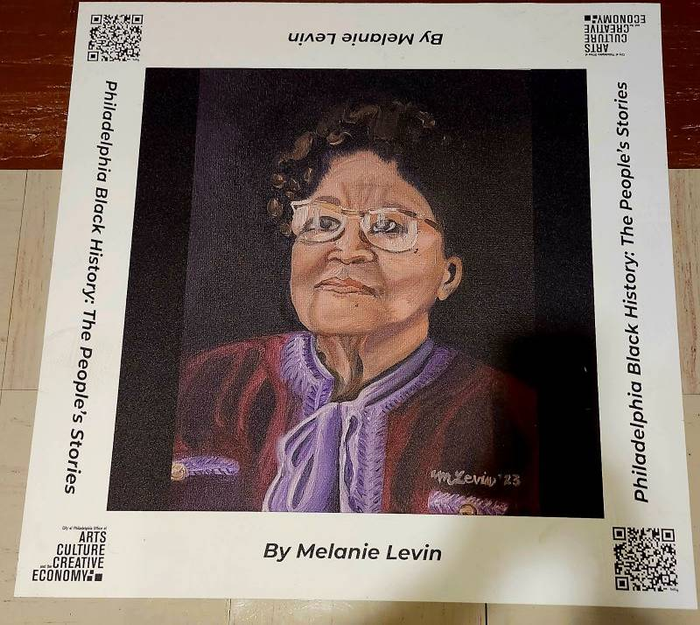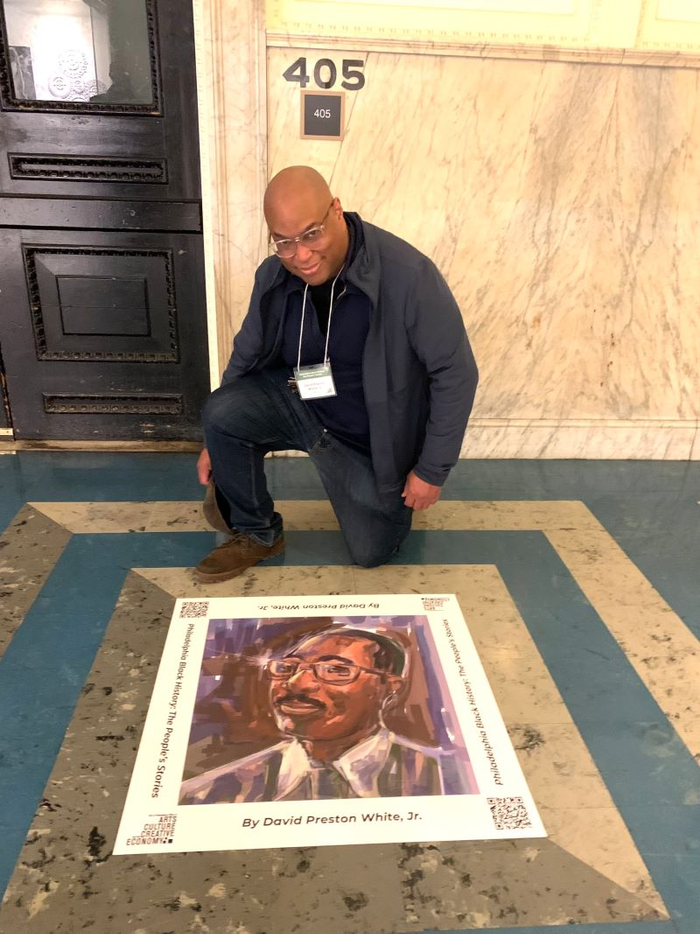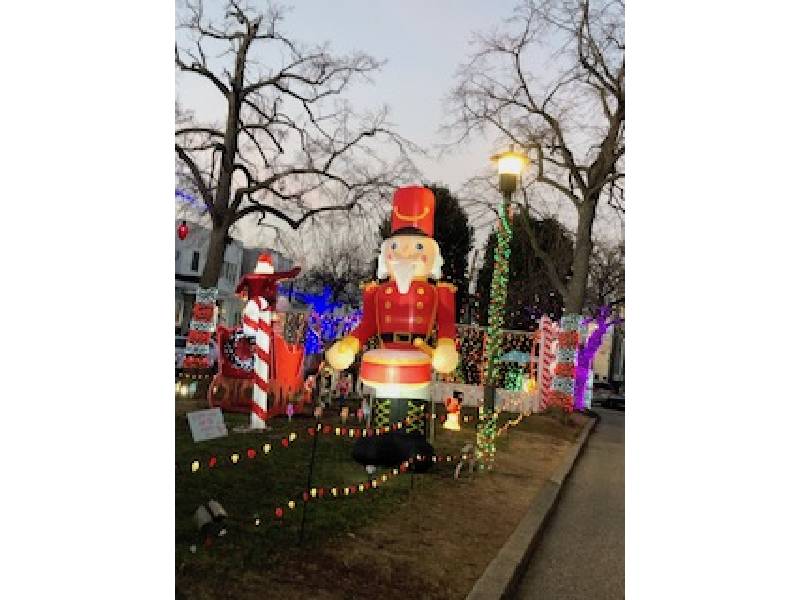Featured works by Jamal Stokes, Selene Nunez-Cruz, and Asake Denise Foye Jones.
Photo credit: SueAnn Rybak
“Philadelphia Black History: The People’s Stories” exhibit features the artwork of 44 local artists whose works are tastefully presented on vinyl square tiles arranged on the 2nd, 4th, and 5th floors of Philadelphia’s historic City Hall.
Each work of art is a tribute to a Black Philadelphian who passed away. The artists selected for the exhibit responded to an open call to help tell the stories of, according to the exhibit’s promotional material, “members of one’s family, a prominent figure in the Philadelphia community, or someone personally significant to the artist, whose life should be elevated and remembered through art.”
Many of the people are famous such as legendary entertainers John Coltrane, Marian Anderson, and Pearl Bailey. Others are not as well-known, but all contributed ultimately to the history of the rich African-American experience in Philadelphia.
Azsanee’ Truss’ tile tells the story of Toni Cade Bambara, an author, filmmaker, and activist.
Bambara wrote the script for and narrated “The Bombing of Osage Avenue,” a documentary about the police siege of the MOVE compound in West Philadelphia on May 13, 1985 – one of the city government’s most infamous and tragic moments. Bambara is best known for her novel, “Those Bones Are Not My Child.” It was edited by writer Toni Morrison and published posthumously in 1999.
“Though I am not biologically related to Bambara, I consider her to be an intellectual ancestor of mine,” said Truss. “As a Black feminist scholar and artist, her life and writings serve as a blueprint for the type of work I aim to do in this lifetime. She created freely and lived fiercely, and her impact will be forever felt.”

Asake Denise Foye-Jones -artist
Tribute to Dorothy Foye Miss D
artist mother
business owner and seamstress
Photo credit: SueAnn Rybak
Asake Denise Foye-Jones’ tile pays tribute to her mother Dorothy Foye a.k.a. “Miss D.” Miss D was the first Black woman credited with opening a business near 45th and Walnut streets. She owned a boutique that offered dressmaking and tailoring services. Miss D was known for her craftsmanship, both regionally and nationally. Willi Smith, a well-known Black fashion and set designer employed at the Forrest Theater, was one of her many clients.
“When it came to the love of fabric, my mother and I had a seamless relationship,” Foye-Jones said, referring to their love for fashion. “This piece is an homage to her creative, tenacious, and authentic spirit.”
Inspired by 5,000 forgotten souls buried at the Bethel Burying Ground, “The Philadelphia Black History: The People’s Stories” is sourced from one of the first independent cemeteries for free Blacks in the area.
The cemetery was forgotten for centuries until it was re-discovered in 2013 under the Weccacoe Playground in the Queen Village neighborhood of South Philadelphia.
“The folks who were buried at the Bethel Burying Ground were so prominent and relevant to their time,” said Tu Huynh, program manager for the Art in City Hall program in the Philadelphia Office of Arts, Culture, and the Creative Economy. “They were the first free Black community, perhaps in the entire country. These are the folks that [American abolitionist and social activist] Harriet Tubman met when she visited Philadelphia. It was perhaps what inspired her to continue to help people move from enslavement to freedom.
The exhibit includes many wonderful examples of the forgotten and unheralded; important people like Sadie Tanner Mossell Alexander, a civil rights activist. She was the first African-American woman to pass the Pennsylvania Bar Examination.

Melanie Levin artist
Entitled Sadie Alexander
Tribute to Sadie Tanner Mossell Alexander
Pioneering Civil Rights activist
1898 to 1989
Photo credit: SueAnn Rybak
“Alexander worked for a time at the city solicitor’s office, and this artist, Melanie Levin, is an acting deputy city solicitor,” Huynh said.
While Levin is not related to Alexander, the artist wrote in a statement that she feels “connected to and inspired by her [Alexander’s] career as a public servant.”
Huynh said it’s these “connections” that remind us of the importance of African-American history and why these stories should not be forgotten but celebrated.
The exhibit runs until Friday, April 12, 2024. It is part of a series of art projects in 2024 organized by the city — through a grant “A Peaceful Place: From Burying Ground to Playground” from the National Endowment for the Arts. The goal is to highlight the importance of the Bethel Burying Ground historic site. This effort is being done in advance of its upcoming public art memorial project by artist Karyn Olivier. Her design, “Her Luxuriant Soil,” features white granite and concrete pavers, with inscriptions of those interred. These pavers will be water-activated allowing the inscriptions to become visible only in humid or wet weather.
Other tiles will be blank, representing the interred who have not been identified, and sadly, whose stories have not yet been brought to light.
“The exhibit makes us rethink what constitutes history,” Huynh said, “We don’t want to forget people in our own time.”

artist Selena Nunez-Cruz
Tribute to Mark Grubb-
19th Century Black Philadelphian buried at Bethel Burying Ground
1784-1849
He was a porter, coachman, and laborer
Renowned for his strong work ethic
Photo credit: SueAnn Rybak

artist Jamal Stokes
Tribute to Pearl Bailey (1918-1990)singer/entertainer
photo credit: SueAnn Rybak

David Preston White, Jr. of James G. Spady (1944-2020) entitled ” A Timeless Journey”
Writer, historian, journalist and activist. He helped Cecil B. Moore in the famed and successful protests to desegregate Girard College. Spady co-founded the Black History Museum Library in North Philadelphia.
Photo credit: SueAnn Rybak

David Preston White, Jr. of James G. Spady (1944-2020) entitled ” A Timeless Journey”
Writer, historian, journalist and activist. He helped Cecil B. Moore in the famed and successful protests to desegregate Girard College. Spady co-founded the Black History Museum Library in North Philadelphia.
Photo credit: SueAnn Rybak

Artist Devona Melton, with hertribute to Caroline LeCount entitled “VIEWS.”
Caroline LeCount was a courageous civil rights activist from South Philadelphia, who deserves recognition alongside the legendary Rosa Parks for her pivotal role in challenging segregation.
While Rosa Parks is well-known for her bus boycott, Caroline Le Count’s impact was felt when she was denied access to a streetcar in 1867 because she was black. Despite facing dismissal from authorities, Caroline tenaciously enforced the new law that allowed everyone to ride streetcars and choose their seats, irrespective of race. This bold move resulted in the driver being fined, marking a triumph for civil rights.
She was the first African American to pass the teaching exam in Philadelphia.
At the age of 21, she was the second female African American principal in Philadelphia.
Photo credit: The Philadelphia Office of Arts, Culture, and the Creative Economy

Visitors look at the exhibit at City Hall in Philadelphia. Photo credit: The Philadelphia Office of Arts, Culture, and the Creative Economy





